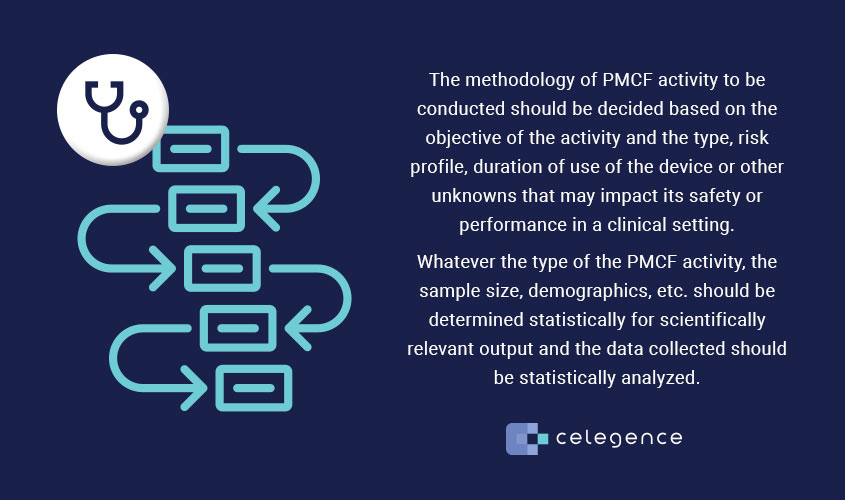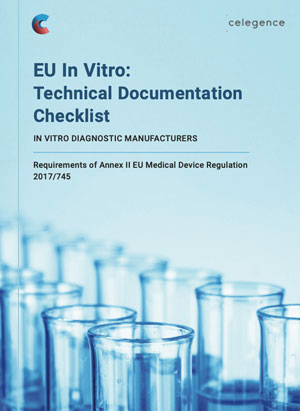
What is PMCF?
The goal of all post-market surveillance (PMS) activities is to ensure that the medical device performs as intended and that any potential safety issues are identified as quickly as possible. One of the most crucial parts of your post-market surveillance activities is the post-market clinical follow-up (PMCF). Post Market Clinical Follow up (PMCF) for medical devices is meant to be a systematic and proactive method of collecting and evaluating clinical data on how your device is used post market, and the outcomes of its use. According to MDR Annex XIV Part B, PMCF should be a continuous process throughout the lifetime of a device.
The aim of PMCF is to:
- Confirm the safety and performance, including the clinical benefit(s), of the device throughout its expected lifetime.
- Identify previously unknown side-effects and monitor the identified side-effects and contraindications.
- Identify and analyze emergent risks on the basis of factual evidence.
- Ensure the continued acceptability of the benefit-risk ratio.
- Identify possible systematic misuse or off-label use of the device.
PMCF Integration into PMS Process
PMCF is often integrated into the parent PMS process but is of unique importance. A well designed PMS system is expected to have established procedures for collecting all types of complaints and feedback, and includes PMCF activities oriented towards actively collecting clinical data from real world settings. It is not far-fetched to say that the ‘P’ in PMCF does not only stand for post-market, but for ‘Proactive’.
Without evidence of clinical safety and performance, the authorization to distribute the products is no longer valid!
The checklist highlights all of the documentation that you will need in place for certification of your IVD device and will serve as a guide to help you achieve ongoing compliance. In conjunction with this checklist, we are also able to provide you with bespoke strategies to bring your business up to speed. We are currently working with businesses from the United States, India, and throughout Europe to ensure that they are ready for the deadline in May of 2022.
When is PMCF required?
The decision to conduct PMCF studies must be based on the identification of possible residual risks and/or unclarity on long term clinical performance that may impact the benefit/risk ratio.
The methodology of PMCF activity to be conducted should be decided based on the objective of the activity and the type, risk profile, duration of use of the device or other unknowns that may impact its safety or performance in a clinical setting. Whatever the type of the PMCF activity, the sample size, demographics, etc. should be determined statistically for scientifically relevant output and the data collected should be statistically analyzed.
The objectives of a planned PMCF activity should consider the following:
- Intended use, indications, and clinical benefits of the device
- Clinical claims of safety and performance on the promotional material that require substantiating clinical evidence
- Clinical safety or performance characteristics for which equivalence is claimed in the clinical evaluation
- Results of the clinical evaluation (e.g., new risk or safety/performance outcome with insufficient clinical evidence)
- Useful life of the device
According to Annex III 1.1b PMS should include: “a PMCF plan” as referred to in Part B of Annex XIV, or a justification as to why a PMCF is not applicable.”

When Is a PMCF Study Mandatory?
The higher risk associated with a medical device, the more important PMCF is. It is to be noted that a PMCF plan is required in all cases, even if the measures themselves have been justified as unnecessary.
PMCF study is mandatory if:
- CE mark under MDD was based on equivalence.
- Subject device is based on novel technology
- Long term safety or performance is unknown or unclear
- It is intended for high risk population e.g., patients with an implantable device (active or non-active)
- There are unstudied subpopulations which may show different benefit/risk-ratio.
- There is a possibility of interaction with other medical products or treatments.
When is the justification for not conducting PMCF valid?
It is quite clear from the observations of notified bodies that PMCF is not an optional requirement, regardless of the risk classification of a medical device. However, it is acceptable to justify non-application during the clinical evaluation. This justification depends on the type of device, the intended purpose and the risk class, and must explain in an evidence-based argument why PMCF is not necessary.
Per MEDDEV 2.12/2 Rev2 Section 5, PMCF studies may not be required when the medium- and long-term safety and clinical performance are already known from previous use of the device or where other appropriate PMS activities would provide sufficient data to address the risks. For Class III and implantable devices, a specific PMCF study may be waived in one of the following situations:
- Your device was designed by modifying a device you have already placed on the market.
- You have demonstrated that the modified product is equivalent to the product already on the market and your Notified Body accepts the demonstration.
- The clinical evaluation of the device already placed on the market has demonstrated the applicable General Safety and Performance Requirements for the modified device.
An appropriate PMCF Plan is still required, documenting the general PMCF activities that the manufacturer plans to undertake for gathering post market clinical data.
Justification When PMCF Is Not Necessary for PMS
Where PMCF as part of the PMS plan for the device is not deemed necessary, this must be duly justified and documented by:
- Continuous surveillance of scientific literature.
- Continuous evaluation of clinical data relating to equivalent or similar devices.
- Periodic review of data through ongoing PMS activities.
- Ensuring the continued acceptability of the benefit-risk ratio in all intended uses.
- The benefit/risk ratio that will be considered as acceptable for the devices when used as intended in its target treated population, as long as intended users are appropriately informed about known limitations and risks associated with the use of such devices.
Appropriate PMS Activities
In the absence of PMCF, the manufacturer must set up appropriate PMS activities in accordance with the PMS Plan that provide sufficient data to adequately assess risks and benefits on an ongoing basis:
- Electronic surveys consist of end user feedback on device safety and performance, frequency of use, usability, and information materials.
- Trend analysis of complaint data
- Continuous monitoring of any significant changes to the product or to its intended use for which premarket clinical evaluation and re-certification has been completed.
- Continuous monitoring of high risk target populations e.g., paediatric or elderly.
- Continuous monitoring of results from previous clinical investigations, including adverse events.
- Continuous monitoring of Products Quality Systems and vigilance records

EU MDR PMCF Specialists
The conclusions from the PMCF data must be documented in the PMCF Evaluation Report, which must also include as assessment of the impact of the PMCF outcomes on other parts of the technical documentation, such as updates to risk management file, clinical evaluation report, instructions for use/user manual, or changes to design documents, or additional verification/validation requirements.
Celegence, led by CEO Sonia Veluchamy, is your expert in PMCFs for EU MDR compliance. Reach out today and learn how Celegence can streamline your compliance requirements, info@celegence.com or contact us online.
The checklist highlights all of the documentation that you will need in place for certification of your IVD device and will serve as a guide to help you achieve ongoing compliance. In conjunction with this checklist, we are also able to provide you with bespoke strategies to bring your business up to speed. We are currently working with businesses from the United States, India, and throughout Europe to ensure that they are ready for the deadline in May of 2022.



